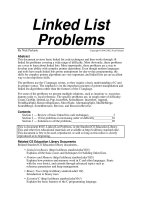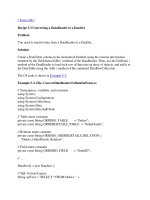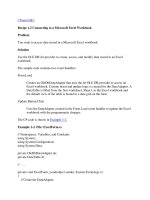Insert Node to a Linked List
Bạn đang xem bản rút gọn của tài liệu. Xem và tải ngay bản đầy đủ của tài liệu tại đây (408.82 KB, 42 trang )
Insert Node to a Linked List
1. Allocate memory for the new node and set up data.
2. Locate the pointer p in the list, which will point to the new
node:
If the new node becomes the first element in the List: p is head.
Otherwise: p is pPre->link, where pPre points to the predecessor
of the new node.
30
head
…
pNew
x
pPre
pNew
head
…
x
Insert Node to a Linked List
(cont.)
3. Update pointers:
– Point the new node to its successor.
– Point the pointer p to the new node.
31
head
…
X
pNew
X
pNew->link = pPre->link (1)
pPre->link = pNew (2)
pPre
(1)
(2)
pNew->link = head (1)
head= pNew (2)
X
head
…
pNew
X
(1)
(2)
Insert Node to a Linked List
(cont.)
Insertion is successful when allocation memory for the
new node is successful.
32
Insert Node to a Linked List
(cont.)
There is no difference between
insertion in the middle (a) and insertion at the end
of the list (b)
(a)
(b)
33
head
…
X
pNew
X
pNew->link = pPre->link (1)
pPre->link = pNew (2)
pPre
(1)
(2)
pPre
pNew
head
…
x
Insert Node to a Linked List
(cont.)
There is no difference between
insertion at the beginning of the list (a) and insertion
to an empty list (b).
(a)
(b)
34
pNew
head
pNew
pNew->link = head (1)
head= pNew (2)
X
head
…
pNew
X
(1)
(2)
head
Insert Algorithm
<ErrorCode> Insert (val DataIn <DataType>)
// For ordered list.
Inserts a new node in a singly linked list.
Pre DataIn contains data to be inserted
Post If list is not full, DataIn has been inserted; otherwise, list
remains unchanged.
Return success or overflow.
35
InsertNode Algorithm (cont.)
<ErrorCode> Insert (val DataIn <dataType>)
1. Allocate pNew
2. if (memory overflow)
1. return overflow
3. else
1. pNew->data = DataIn
2. Locate pPre // pPre remains NULL if Insertion at the beginning
or to an empty list
3. if (pPre = NULL) // Adding at the beginning or to an empty list
1. pNew->link = head
2. head = pNew
4. else // Adding in the middle or at the end of the list
1. pNew->link = pPre->link
2. pPre->link = pNew
5. return success
end Insert
36
Remove Node from
a Linked List
1. Locate the pointer p in the list which points to the node to be
deleted (pDel will hold the node to be deleted).
If that node is the first element in the List: p is head.
Otherwise: p is pPre->link, where pPre points to the
predecessor of the node to be deleted.
37
…
…
pPre pDel
pDel
head
head
Remove Node from
a Linked List (cont.)
2. Update pointers: p points to the successor of the node to be
deleted.
3. Recycle the memory of the deleted node.
head
…
pDel
X
head
…
pDel
X
pPre
head = pDel->link
Recycle pDel
pPre->link = pDel->link
Recycle pDel
38
Remove Node from
a Linked List (cont.)
Removal is successful when the node to be deleted is found.
39
Remove Node from
a Linked List (cont.)
There is no difference between
Removal a node from the middle (a) and removal a node
from the end (b) of the list.
(a)
(b)
40
head
…
pDel
X
pPre
head
…
pDel
pPre
pPre->link = pDel->link
Recycle pDel
pDel
X
pPre
head
…
Remove Node from
a Linked List (cont.)
There is no difference between
removal the node from the beginning (a) of the list and
removal the only-remained node in the list (b).
(a)
(b)
41
head
pDel
head
pDel
head
…
pDel
X
head = pDel->link
Recycle pDel
RemoveNode Algorithm
<ErrorCode> Remove (ref DataOut <DataType>)
Removes a node from a singly linked list.
Pre DataOut contains the key need to be removed.
Post If the key is found, DataOut will contain the data
corresponding to it, and that node has been removed from the
list; otherwise, list remains unchanged.
Return success or failed.
42
RemoveNode Algorithm (cont.)
<ErrorCode> Remove (ref DataOut <DataType>)
1. Allocate pPre, pDel // pPre remains NULL if the node to be deleted
is at the beginning of the list or is the only node.
2. if (pDel is not found)
1. return failed
3. else
1. DataOut = pDel->data
2. if (pPre = NULL) // Remove the first node or the only node
1. head = pDel->link
3. else // Remove the node in the middle or at the end of the list
1. pPre->link = pDel->link
4. recycle pDel
5. return success
end Remove
43
Search Algorithm for
Auxiliary Function in Class
This search algorithm is not a public method of List
ADT.
Sequence Search has to be used for the linked list.
This studying for the case: List is ordered accordingly
to the key field.
44
Search Algorithm for
Auxiliary Function in Class
• Public method Search of List ADT:
<ErrorCode> Search (ref DataOut <DataType>)
Can not return a pointer to a node if found.
• Auxiliary function Search of List ADT:
<ErrorCode> Search (val target <KeyType>,
ref pPre <pointer>,
ref pLoc <pointer>)
Searches a node and returns a pointer to it if found.
45









